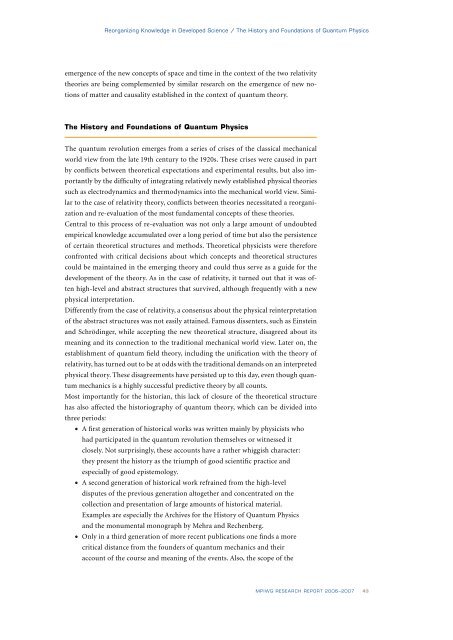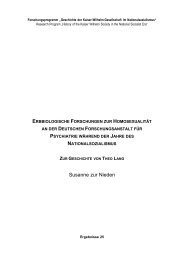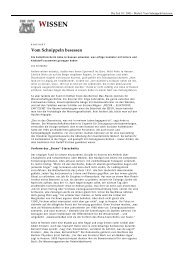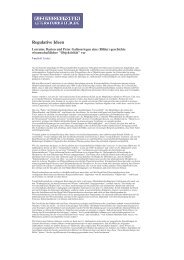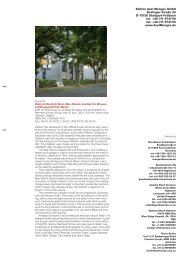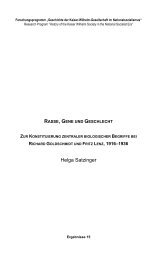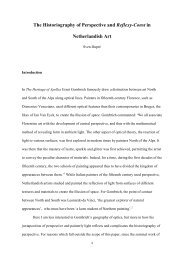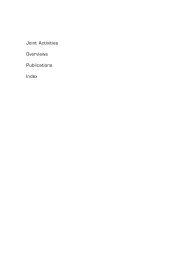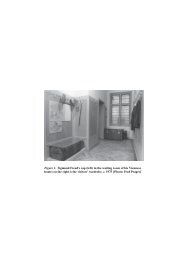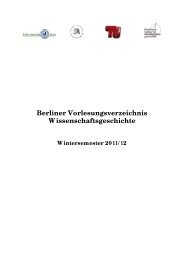Max Planck Institute for the History of Science
Max Planck Institute for the History of Science
Max Planck Institute for the History of Science
You also want an ePaper? Increase the reach of your titles
YUMPU automatically turns print PDFs into web optimized ePapers that Google loves.
emergence <strong>of</strong> <strong>the</strong> new concepts <strong>of</strong> space and time in <strong>the</strong> context <strong>of</strong> <strong>the</strong> two relativity<br />
<strong>the</strong>ories are being complemented by similar research on <strong>the</strong> emergence <strong>of</strong> new no-<br />
tions <strong>of</strong> matter and causality established in <strong>the</strong> context <strong>of</strong> quantum <strong>the</strong>ory.<br />
The <strong>History</strong> and Foundations <strong>of</strong> Quantum Physics<br />
The quantum revolution emerges from a series <strong>of</strong> crises <strong>of</strong> <strong>the</strong> classical mechanical<br />
world view from <strong>the</strong> late 19th century to <strong>the</strong> 1920s. These crises were caused in part<br />
by conflicts between <strong>the</strong>oretical expectations and experimental results, but also im-<br />
portantly by <strong>the</strong> difficulty <strong>of</strong> integrating relatively newly established physical <strong>the</strong>ories<br />
such as electrodynamics and <strong>the</strong>rmodynamics into <strong>the</strong> mechanical world view. Simi-<br />
lar to <strong>the</strong> case <strong>of</strong> relativity <strong>the</strong>ory, conflicts between <strong>the</strong>ories necessitated a reorgani-<br />
zation and re-evaluation <strong>of</strong> <strong>the</strong> most fundamental concepts <strong>of</strong> <strong>the</strong>se <strong>the</strong>ories.<br />
Central to this process <strong>of</strong> re-evaluation was not only a large amount <strong>of</strong> undoubted<br />
empirical knowledge accumulated over a long period <strong>of</strong> time but also <strong>the</strong> persistence<br />
<strong>of</strong> certain <strong>the</strong>oretical structures and methods. Theoretical physicists were <strong>the</strong>re<strong>for</strong>e<br />
confronted with critical decisions about which concepts and <strong>the</strong>oretical structures<br />
could be maintained in <strong>the</strong> emerging <strong>the</strong>ory and could thus serve as a guide <strong>for</strong> <strong>the</strong><br />
development <strong>of</strong> <strong>the</strong> <strong>the</strong>ory. As in <strong>the</strong> case <strong>of</strong> relativity, it turned out that it was <strong>of</strong>-<br />
ten high-level and abstract structures that survived, although frequently with a new<br />
physical interpretation.<br />
Differently from <strong>the</strong> case <strong>of</strong> relativity, a consensus about <strong>the</strong> physical reinterpretation<br />
<strong>of</strong> <strong>the</strong> abstract structures was not easily attained. Famous dissenters, such as Einstein<br />
and Schrödinger, while accepting <strong>the</strong> new <strong>the</strong>oretical structure, disagreed about its<br />
meaning and its connection to <strong>the</strong> traditional mechanical world view. Later on, <strong>the</strong><br />
establishment <strong>of</strong> quantum field <strong>the</strong>ory, including <strong>the</strong> unification with <strong>the</strong> <strong>the</strong>ory <strong>of</strong><br />
relativity, has turned out to be at odds with <strong>the</strong> traditional demands on an interpreted<br />
physical <strong>the</strong>ory. These disagreements have persisted up to this day, even though quan-<br />
tum mechanics is a highly successful predictive <strong>the</strong>ory by all counts.<br />
Most importantly <strong>for</strong> <strong>the</strong> historian, this lack <strong>of</strong> closure <strong>of</strong> <strong>the</strong> <strong>the</strong>oretical structure<br />
has also affected <strong>the</strong> historiography <strong>of</strong> quantum <strong>the</strong>ory, which can be divided into<br />
three periods:<br />
Reorganizing Knowledge in Developed science / <strong>the</strong> history and Foundations <strong>of</strong> Quantum Physics<br />
· A first generation <strong>of</strong> historical works was written mainly by physicists who<br />
had participated in <strong>the</strong> quantum revolution <strong>the</strong>mselves or witnessed it<br />
closely. Not surprisingly, <strong>the</strong>se accounts have a ra<strong>the</strong>r whiggish character:<br />
<strong>the</strong>y present <strong>the</strong> history as <strong>the</strong> triumph <strong>of</strong> good scientific practice and<br />
especially <strong>of</strong> good epistemology.<br />
· A second generation <strong>of</strong> historical work refrained from <strong>the</strong> high-level<br />
disputes <strong>of</strong> <strong>the</strong> previous generation altoge<strong>the</strong>r and concentrated on <strong>the</strong><br />
collection and presentation <strong>of</strong> large amounts <strong>of</strong> historical material.<br />
Examples are especially <strong>the</strong> Archives <strong>for</strong> <strong>the</strong> <strong>History</strong> <strong>of</strong> Quantum Physics<br />
and <strong>the</strong> monumental monograph by Mehra and Rechenberg.<br />
· Only in a third generation <strong>of</strong> more recent publications one finds a more<br />
critical distance from <strong>the</strong> founders <strong>of</strong> quantum mechanics and <strong>the</strong>ir<br />
account <strong>of</strong> <strong>the</strong> course and meaning <strong>of</strong> <strong>the</strong> events. Also, <strong>the</strong> scope <strong>of</strong> <strong>the</strong><br />
MPIWG ReseaRch RePoRt 2006– 2007 43


